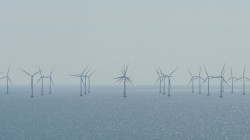Offshore wind farms: too much energy is lost in cables
Offshore wind farms play an increasingly important role in renewable power generation. According to WindEurope, Europe now has a total installed offshore wind capacity of 15,780 MW. This corresponds to 4,149 grid-connected wind turbines across 11 countries. 2017 was a record year for wind-produced energy: twice as much as 2016. But there is an important technical issue. Most of the existing offshore wind farms transmit their power to the mainland using high-voltage alternating current. The problem with this technology is that too much energy is lost in cables because wind turbines are located very far from the mainland. This obstacle could be overcome using HVDC (high-voltage direct current transmission) that has much lower losses. In Demo 1 of the EU Best Paths project, researchers studied ways of connecting offshore windfarms with HVDC grids to improve the availability of power. We spoke about this issue with Iñigo Azpiri, Innovation Manager at Iberdrola Renewables based in Bilbao, Spain, which is one of the world’s largest renewable energy firms. Is it possible to do more in the field of offshore wind farms? Much more can still be done. The largest wind farm projects are yet to come. They are located very far from shore, with distances of over 120 km, where the wind blows with more constant speed and with less turbulence. The distance limitation can be solved with new transmission technologies like high-voltage direct current (HVDC), which overcomes the limitations of traditional alternating current (AC). Further into the future, these wind farms will be interconnected, allowing the transfer of energy among neighbouring countries. What are, more precisely, the advantages of HVDC in the place of AC? Due to the very nature of alternating current, the power through an AC cable is comprised of active and reactive power. Active power is what we use at home to heat it or turn the lights on. Reactive power is of great importance because it is what enables the electromagnetic fields that are needed to transmit energy. The problem is that the longer the cable, the more reactive power it needs, until at a certain distance only a small fraction of the cable capacity is used for the active power. HVDC cables are not affected by this, so they can be used to evacuate the energy produced by very distant offshore wind farms without losses. Additionally, DC cables have a smaller cross section for the equivalent power, so they are cheaper to build and easier to handle during the installation. Offshore wind farms and converter stations are getting bigger and bigger. Is this a problem? The problem nowadays is the large size of the converter stations, which transform AC voltages generated by the wind farms to DC for the transmission, as well as the problems that arise when we want to interconnect several converters, especially if they are built by different manufacturers. If these limitations are overcome and the industry manages to lower the costs of the technology, we will be able to deploy a grid that can send renewable energy to large distances across Europe and improve the reliability of the grid thanks to the redundant paths that it will provide. At the moment, is offshore wind energy competitive with other energy sources? Offshore wind energy has come to a point where it can start competing with traditional energy sources like new nuclear and gas. Many countries have already started their transition to renewable sources, and for example in the UK, a country surrounded by offshore wind farms, 40% of the capacity coming from old nuclear, gas and coal plants will be replaced by cleaner sources by 2024. Read more: http://www.bestpaths-project.eu/en/news/offshore-wind-farms-too-much-energy-is-lost-in-cables
Keywords
smart grid, energy, efficiency
Countries
Spain



